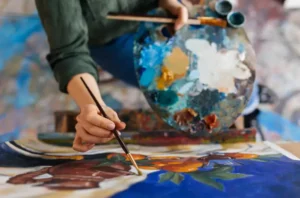 Art isn’t just decoration. It’s translation — a way the human mind turns emotion into something visible. We paint, write, sing, and build not because we want to impress, but because we’re trying to understand what’s inside us.
Art isn’t just decoration. It’s translation — a way the human mind turns emotion into something visible. We paint, write, sing, and build not because we want to impress, but because we’re trying to understand what’s inside us.
Every drawing, poem, or melody is a message from the subconscious, disguised as beauty. That’s why art can move you even when you don’t understand it — because your mind recognizes something familiar before your logic does.
The Mind Behind the Canvas
Psychology and art have always been quiet partners. Freud studied dreams like they were poems. Jung collected paintings from his patients to explore their inner worlds. When people create art, they’re not just expressing — they’re processing. A brushstroke or a line of music becomes a safe way to release thoughts that don’t have words. That’s why art therapy works: it bypasses the thinking mind and goes straight to the emotional core. You can lie in speech, but not in color. Even when artists say, “I don’t know why I made this,” the truth is — their mind does. The artwork often knows the answer before they do.
Why We Feel Art Before We Understand It
When you stand in front of a painting and feel something — calm, tension, nostalgia — your brain isn’t analyzing technique. It’s responding to form, rhythm, and tone the same way it reacts to memory and emotion.
Neurologically, art activates the same regions that process empathy and imagination. That’s why certain colors or sounds can change mood instantly. It’s also why beauty can feel painful — because it stirs emotions you didn’t expect to find.
Art, in this sense, is emotional language. It speaks in symbols, not sentences. And the psyche — that vast, mysterious landscape beneath logic — speaks the same way.
Creation as Healing
Making art can be an act of rebellion or survival. People often turn to painting, music, or writing during grief, anxiety, or loss — not to create masterpieces, but to create order.
When life feels chaotic, art offers structure. The act of shaping something — even a mess of paint or clay — gives the brain a sense of control. It’s the mind saying, I can still make meaning, even out of pain.
That’s why people who never considered themselves “creative” suddenly find comfort in drawing or journaling during hard times. Creation isn’t about talent; it’s about processing experience.
And sometimes, the only way to heal is to make something beautiful from what hurt you.
The Mirror Effect
Art doesn’t just heal the creator — it heals the viewer too.
When you look at someone else’s work and feel seen, it’s because your psyche recognizes itself in their creation. That’s what makes art universal. It reminds us that our private emotions are, in fact, shared.
A stranger’s poem can describe your heartbreak better than you ever could. A painting can show your anxiety without using a single word. Art connects what we think is isolated inside us to something collective, human, and ancient.
It’s the closest thing to emotional telepathy we’ve ever invented.
The Dark Side of Creation
Of course, not all art heals. Some artists dig so deep into their psyche that they uncover things they can’t put back. The same sensitivity that fuels creativity can also make people more vulnerable to depression or burnout.
That’s why the idea of the “tortured artist” exists — not because pain makes great art, but because great artists feel everything more intensely.
Still, the connection between creativity and mental health isn’t tragedy — it’s awareness. When handled with care, art becomes a tool to understand that intensity, not drown in it.
The Bottom Line
Art and psychology aren’t separate worlds — they’re reflections of each other. One studies the mind with science; the other studies it with color, sound, and story.
Both ask the same question: Who am I, really?
And while psychology may analyze, art experiences. It reminds us that understanding yourself isn’t always about explanation. Sometimes, it’s about expression.
Because deep down, every piece of art — whether it’s a painting, a song, or a quiet sketch in a notebook — is a simple, timeless message from the human mind to itself:
“I’m still here. I still feel. And I’m trying to make sense of it.”
Picture Credit: Freepik
